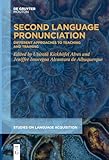Second Language Pronunciation : Different Approaches to Teaching and Training / ed. by Ubiratã Kickhöfel Alves, Jeniffer Imaregna Alcantara de Albuquerque.
Material type: TextSeries: Studies on Language Acquisition [SOLA] ; 64Publisher: Berlin ; Boston : De Gruyter Mouton, [2022]Copyright date: ©2023Description: 1 online resource (XIII, 415 p.)Content type:
TextSeries: Studies on Language Acquisition [SOLA] ; 64Publisher: Berlin ; Boston : De Gruyter Mouton, [2022]Copyright date: ©2023Description: 1 online resource (XIII, 415 p.)Content type: - 9783110739510
- 9783110736144
- 9783110736120
- 421
- online - DeGruyter
- Issued also in print.
| Item type | Current library | Call number | URL | Status | Notes | Barcode | |
|---|---|---|---|---|---|---|---|
 eBook
eBook
|
Biblioteca "Angelicum" Pont. Univ. S.Tommaso d'Aquino Nuvola online | online - DeGruyter (Browse shelf(Opens below)) | Online access | Not for loan (Accesso limitato) | Accesso per gli utenti autorizzati / Access for authorized users | (dgr)9783110736120 |
Frontmatter -- About the Authors -- Contents -- Introduction -- Part I: Pronunciation development and intelligibility: Implications for teaching and training studies -- Plural formation in English: A Brazilian Portuguese case study -- Effect of task, word length and frequency on speech perception in L2 English: Implications for L2 pronunciation teaching and training -- L2 accented speech measured by Argentinian pre-service teachers -- Dynamic paths of intelligibility and comprehensibility: Implications for pronunciation teaching from a longitudinal study with Haitian learners of Brazilian Portuguese -- Part II: L2 pronunciation teaching -- A dynamic account of the development of English (L2) vowels by Brazilian learners through communicative teaching and through explicit instruction -- An extra layer of support: Developing an English-speaking consultation program -- Putting participation first: The use of the ICF-model in the assessment and instruction of L2 pronunciation -- Part III: L2 pronunciation training: Implications for the classroom -- Orthographic interference in the acquisition of English /h/ by Francophones -- Improving fossilized English pronunciation by simultaneously viewing a video footage of oneself on an ICT self-learning system -- Speech technologies and pronunciation training: What is the potential for efficient corrective feedback? -- Part IV: Pronunciation in the laboratory: High variability phonetic training -- On the robustness of high variability phonetic training effects: A study on the perception of non-native Dutch contrasts by French-speaking learners -- Effects of perceptual training in the perception and production of heterotonics by Brazilian learners of Spanish -- Assessing the robustness of L2 perceptual training: A closer look at generalization and retention of learning -- Conclusion -- An overview of pronunciation teaching and training -- Index
restricted access online access with authorization star
http://purl.org/coar/access_right/c_16ec
In the field of second language (L2) acquisition, the number of studies focusing on L2 pronunciation instruction and perceptual/production training has increased as new classroom methodologies have been proposed and new goals for L2 pronunciation have been set. This book brings together different approaches to L2 pronunciation research in the classroom or in the language laboratory. 13 chapters, written by well-known researchers focusing on a variety of first and target languages, are divided into four parts: Pronunciation development and intelligibility: implications for teaching and training studies; L2 pronunciation teaching; L2 pronunciation training: implications for the classroom; and Pronunciation in the laboratory: High Variability Phonetic Training. Intended for researchers in the fields of second language acquisition, phonetics, phonology, psycholinguistics, speech therapies, speech technology, as well as second language teaching, this book not only summarizes the current research questions on L2 pronunciation teaching and training, but also predicts future scenarios for both researchers and practitioners in the field.
Issued also in print.
Mode of access: Internet via World Wide Web.
In English.
Description based on online resource; title from PDF title page (publisher's Web site, viewed 25. Jun 2024)


